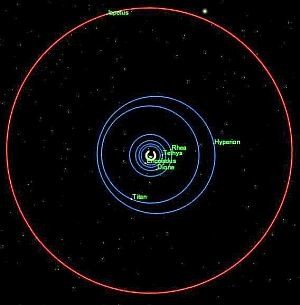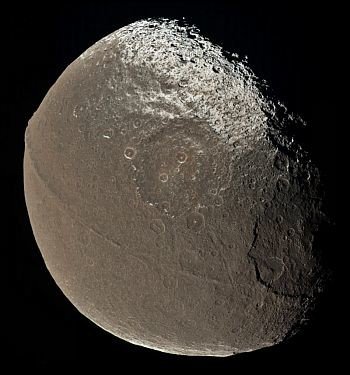Iapetus (moon) of Saturn
Iapetus (moon) is named after Titan Iapetus from Greek mythology. It is also known as Saturn VIII and is the third largest moon of Saturn and the eleventh largest in the Solar System. Iapetus was discovered by an Italian astronomer, Giovanni Domenico Cassini on 25 Oct 1671.
The moon takes 79.3215 days to rotate and revolve (synchronous rotation) around Saturn and its average orbital speed is 3.26 km/s. The dimensions of the moon are 1,492.0 × 1,492.0 × 1,424 km in diameter and the surface area is 6700000 sq km.
The low density (1.088±0.013 g/cm³) of Iapetus indicates that it is mostly composed of ice with a small amount of rocky materials. Iapetus is neither spherical nor ellipsoid, it has a big bulging waistline and has compressed poles. The equatorial ridge is very high and is visible even when viewed from a distance. The rim is 1,300 km long, 20 km wide, and 13 km high. Iapetus has a lot of craters along with large impact basins. At least five craters are over 350 km wide and the largest (Turgis) has a diameter of 580 km.
Giovanni Cassini observed that he could only view Iapetus on the west side of Saturn. He concluded that Iapetus is locked in synchronous rotation about Saturn and that one side is darker than the other, which was later confirmed by large telescopes. The dark hemisphere of Iapetus is named Cassini Regio in honor of Giovanni Cassini.

Image Source The red circle is the orbit of Iapetus around Saturn
Cassini orbiter has imaged Iapetus multiple times from moderated distances. The orbital diameter of the moon is very large and hence is quite far from Saturn which makes close observation very difficult. The closest targeted flyby of Iapetus was at a minimum range of 1,227 km (762 mi), on 10 Sep 2007.
Source: Wikipedia
Read Also: Hyperion also known as Saturn VII
If you liked my post, then please give an Upvote and Resteem it or follow me, you will be thanked.

Thank you for your contribution. Dont forget to link references and sources when applicable!
=======================================================================================
This post was upvoted and resteemed by @Steemgridcoin with the aim of promoting discussions surrounding Gridcoin and science.
This service is free. Please follow @steemgridcoin if you want to support this initiative.
Have a nice day. :)
Congratulations @eforucom! You have received a personal award!
Click on the badge to view your Board of Honor.
Congratulations @eforucom! You have completed the following achievement on Steemit and have been rewarded with new badge(s) :
Click on the badge to view your Board of Honor.
If you no longer want to receive notifications, reply to this comment with the word
STOPDelightful Saturn: Ringed Planet Shines in New Cassini Photo. ... (Huygens was a piggyback lander that contacted down on Saturn's greatest moon, Titan, in January 2005.) After over 13 long periods of earth-shattering work in the Saturn framework, Cassini was running low on fuel.